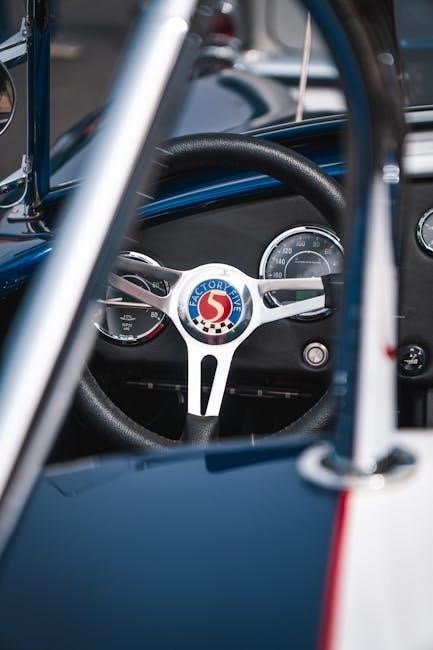
ford three speed manual transmission
The Ford Three-Speed Manual Transmission, known as the Toploader, is a classic gearbox introduced in 1963, offering durability and simplicity for trucks and performance vehicles alike.
Overview of the Ford Three-Speed Manual Transmission
The Ford Three-Speed Manual Transmission, often referred to as the Toploader, is a durable and lightweight gearbox known for its simplicity and reliability. Introduced in 1963, it features a straightforward design with a floor-mounted shifter and was widely used in Ford trucks, Mustangs, and other models. Its robust construction made it a favorite for both daily driving and performance applications, while its ease of maintenance has kept it popular among enthusiasts and restorers.
Historical Context and Development
The Ford Three-Speed Manual Transmission traces its roots to the early 20th century, evolving from basic manual designs. The iconic Toploader, introduced in 1963, replaced the BorgWarner T-10, offering improved durability and a compact design. It became a staple in Ford trucks and performance vehicles, known for its robustness and ease of repair, making it a favorite among enthusiasts and restorers for decades.
Purpose and Applications in Ford Vehicles
The Ford Three-Speed Manual Transmission was primarily designed for simplicity and reliability, serving as a cost-effective option for various Ford models. It was widely used in trucks like the F-100 to F-250, as well as in economy cars such as the Falcon and Comet. Additionally, it was featured in early Mustangs, offering a lightweight, durable alternative for both everyday driving and performance needs.

History and Evolution of the Ford Three-Speed Manual Transmission
Introduced in 1963, the Ford Three-Speed Manual Transmission, known as the Toploader, became a staple in Ford vehicles, offering durability and simplicity before its discontinuation.
Early Versions: 1940s-1950s
The Ford three-speed manual transmission first appeared in the 1940s, featuring a simple, non-synchronized design. These early versions were used in Ford trucks, such as the F-1 and F-100, and were known for their durability and straightforward operation. The lack of synchromesh required double-clutching, but their reliability made them suitable for the era’s vehicles and driving conditions.
The Toploader, introduced in 1963, marked a significant upgrade to Ford’s three-speed manual transmission. It replaced the BorgWarner T-10, offering improved synchromesh and a more robust design. Known for its external gear shifter, the Toploader became a popular choice for Ford vehicles, including trucks and performance cars, lasting through the early 1970s with its reliable and durable construction.
Discontinuation and Legacy
Ford discontinued the three-speed manual transmission in the early 1970s, replaced by four-speed and automatic options. Despite its discontinuation, the Toploader gained a cult following for its simplicity and durability. It remains popular among classic car enthusiasts and restorers, particularly in iconic models like the Mustang and F-Series trucks, symbolizing a bygone era of automotive design.

Identification and Specifications
The Ford Three-Speed Manual Transmission is easily identified by its Toploader design and serial number tags located on the bell housing or passenger side casing, ensuring accurate model verification.
Key Features and Design Elements
The Ford Three-Speed Manual Transmission features a robust Toploader design with a three-speed configuration, known for its durability and simplicity. It includes a manual gearshift, a strong countershaft, and a reliable synchromesh system for smooth shifting. The transmission’s compact size and lightweight construction made it ideal for both trucks and performance vehicles, ensuring versatility across various applications.
Serial Number and ID Tag Locations
The serial number and ID tag on the Ford Three-Speed Manual Transmission are typically located on the passenger side near the front case or on the bell housing. For the 3.03 model, the tag is found on the passenger side of the casing. These identifiers help in decoding the transmission’s specifications and model details for maintenance or replacement purposes.
Technical Specifications and Model Variations
The Ford Three-Speed Manual Transmission features a 3.03-inch centerline distance between the countershaft and input shaft. Variations include the HFF model for trucks and lighter-duty options for passenger vehicles. These transmissions are known for their robust design, with specific gear ratios suited for different applications, ensuring reliability across various Ford models and engine configurations.

Popular Models Equipped with the Ford Three-Speed Manual Transmission
- Ford trucks (F-100 to F-250)
- Ford Mustang and other pony cars
- Falcon, Ranchero, and Comet models
Ford Trucks: F-100 to F-250
The Ford three-speed manual transmission was widely used in Ford trucks, including the F-100 to F-250 series, from 1964 to 1973. Known for its durability, the 3.03 three-speed became a favorite among drivers. Its robust design made it ideal for both light and heavy-duty applications. Today, these transmissions remain popular among restorers and enthusiasts, sought for their simplicity and strength.
Ford Mustang and Other Pony Cars
The Ford Mustang featured the three-speed manual as a standard option, appealing to budget-conscious buyers. Many early models, including the iconic 1965-1967 Mustangs, offered the three-speed alongside optional four-speed and automatic choices. Its simplicity and affordability made it a practical choice for young drivers, though enthusiasts often opted for the four-speed for performance. Despite this, the three-speed remains a cherished piece of Mustang history.
Falcon, Ranchero, and Comet Models
The Ford Falcon, Ranchero, and Comet models were equipped with the three-speed manual transmission, offering a reliable and straightforward driving experience. These compact and mid-size cars featured the 2.77:1 ratio, which was ideal for everyday use. The three-speed became a standard option for budget-conscious buyers, providing simplicity and efficiency, making it a practical choice for drivers prioritizing affordability and ease of operation;

Maintenance and Repair
Regular fluid checks and gasket inspections are essential for the Ford Three-Speed Manual Transmission. Proper maintenance ensures smooth operation and prevents common issues like synchronizer wear and leaks.
Common Maintenance Tasks
Regular lubrication and fluid level checks are crucial for the Ford Three-Speed Manual Transmission. Inspecting the gaskets and seals helps prevent leaks, while monitoring the clutch and gear engagement ensures smooth shifting. Cleaning the transmission housing and replacing worn-out synchronizer rings are also essential tasks to maintain optimal performance and longevity.
Rebuild and Restoration Processes
A Ford Three-Speed Manual Transmission rebuild involves disassembling the unit, inspecting gears, bearings, and synchronizers, and replacing worn components. Special tools are required for proper reassembly. Ensure all parts are cleaned and lubricated before installation. Rebuilding restores functionality and performance, making it a cost-effective option for vintage vehicle enthusiasts and restoration projects.
Tools and Resources for DIY Repairs
DIY repairs for the Ford Three-Speed Manual Transmission require specialized tools like a transmission rebuild kit, bearing puller, and gear setup. Online forums, repair manuals, and video guides provide step-by-step instructions. Rebuilt and remanufactured transmissions are available, ensuring high-quality performance and reliability for enthusiasts restoring classic vehicles.
Common Issues and Troubleshooting
Common issues include syncro wear, bearing failures, and gear grinding. Troubleshooting often involves inspecting for worn parts and addressing fluid leaks promptly to prevent further damage.
Syncro Wear and Bearing Failures
Syncro wear and bearing failures are common issues in Ford three-speed manual transmissions, often caused by high mileage, improper shifting, or insufficient lubrication. Worn synchronizers can lead to gear grinding during shifts, while bearing failure results in noisy operation and potential transmission seizure. Regular maintenance, such as fluid checks and component inspections, can help prevent these issues. Rebuilding or replacing damaged parts is typically required to restore smooth functionality.
Gear Grinding and Shifting Problems
Gear grinding and shifting issues in Ford three-speed manual transmissions often stem from worn synchronizers, misaligned gear teeth, or improper clutch engagement. These problems can be exacerbated by driver error, such as rushing shifts or failing to fully depress the clutch. Over time, this can lead to accelerated wear on gears and synchronizers, necessitating repair or replacement to maintain smooth operation and prevent further damage.
Leakage and Sealing Issues
Leakage in Ford three-speed manual transmissions often occurs due to worn seals, gaskets, or damaged bearing retainers. The overdrive unit and main seal are common sources of leaks. Over time, fluid loss can lead to reduced lubrication and potential damage. Proper sealing requires replacing worn gaskets and ensuring all connections are tight. Regular inspection and maintenance are crucial to prevent these issues from escalating.

Parts Sourcing and Availability
OEM and rebuilt Ford three-speed manual transmission parts are widely available through dealerships, online marketplaces, and specialty suppliers, ensuring longevity for classic and restored vehicles.
OEM vs. Aftermarket Parts
OEM parts for the Ford three-speed manual transmission offer factory specifications and reliability, ideal for restorations. Aftermarket parts provide cost-effective alternatives with modern materials, often enhancing durability. Both options are widely available, catering to enthusiasts seeking authenticity or improved performance. Each choice balances budget and quality, ensuring the transmission’s legacy endures in classic and custom builds.
Rebuilt and Remanufactured Transmissions
Rebuilt and remanufactured Ford three-speed transmissions are popular for classic vehicle restorations. These units undergo thorough inspection, with worn parts replaced and components re-machined to factory specs. Rebuilt transmissions are dyno-tested for quality assurance and often come with a warranty, making them a cost-effective, reliable choice for maintaining originality and performance in vintage Ford models.
Online Marketplaces and Specialty Suppliers
Online marketplaces like eBay, Hemmings, and RockAuto offer a wide range of parts and rebuilt Ford three-speed transmissions. Specialty suppliers, such as Gearhead Transmissions, cater to enthusiasts with remanufactured units. Forums and classic car communities often list private sales or rare components. These platforms provide convenient access to genuine and aftermarket parts, ensuring enthusiasts can restore or upgrade their transmissions with ease and authenticity.

Modern Modifications and Upgrades
The Ford three-speed manual transmission remains popular in modern builds, with enthusiasts enhancing performance through upgraded gear ratios and bearings. Adapter kits enable compatibility with various engines, making it a versatile choice for hot rods and custom projects, blending classic design with contemporary functionality and reliability.
Performance Enhancements
Performance enthusiasts often upgrade the Ford three-speed manual transmission with aftermarket components like lightweight gears and high-performance bearings to improve durability and shift precision. Additionally, installing a Hurst shifter or a short-throw linkage can enhance driver control and responsiveness, making the transmission more suitable for high-performance applications while retaining its classic appeal and reliability.
Installation in Hot Rods and Custom Builds
The Ford three-speed manual transmission is a popular choice for hot rods and custom builds due to its nostalgic appeal and simplicity. Many builders opt for its lightweight design and ease of use, often pairing it with classic engines for a retro driving experience. Custom fabrication, such as clutch linkages and driveshaft alignment, is commonly required to integrate this vintage gearbox into modern projects.
Adapter Kits for Engine Swaps
Adapter kits are essential for engine swaps using the Ford three-speed manual transmission, enabling compatibility with various engines. These kits include custom mounts and spacers to align the transmission with the engine’s bellhousing. Popular swaps involve classic V8s, requiring precise fabrication of components like the Z-bar and driveshaft. This ensures smooth operation and maintains the transmission’s reliability in modified setups.
The Ford Three-Speed Manual Transmission remains a testament to simplicity and durability, cherished by enthusiasts for its role in classic vehicles and hot rod builds.
Legacy of the Ford Three-Speed Manual Transmission
The Ford Three-Speed Manual Transmission, notably the Toploader, holds a revered place in automotive history for its durability and simplicity. Introduced in 1963, it became a staple in Ford trucks and performance vehicles like the Mustang. Its robust design made it a favorite for hot rod builds and restorations. Although eventually replaced by four-speeds, the three-speed remains a sought-after piece for enthusiasts, embodying a bygone era of mechanical elegance and driver engagement.
Collectibility and Restoration Value
The Ford Three-Speed Manual Transmission, particularly the Toploader, has grown in collectibility due to its historical significance and nostalgic appeal. Restored units, especially those paired with classic engines, command high prices. Enthusiasts prize these transmissions for their durability and simplicity, making them valuable for both vintage restorations and custom builds. Original components and proper documentation significantly enhance their market value and desirability.
Future of Manual Transmissions in Classic Cars
Manual transmissions like the Ford Three-Speed remain popular in classic car restorations due to their nostalgic appeal and historical significance. While modern vehicles increasingly favor automatics, enthusiasts continue to seek these gearboxes for their simplicity and connection to the past. The future of manual transmissions lies in niche markets, where they will be cherished for their heritage and mechanical charm in classic builds and restorations.